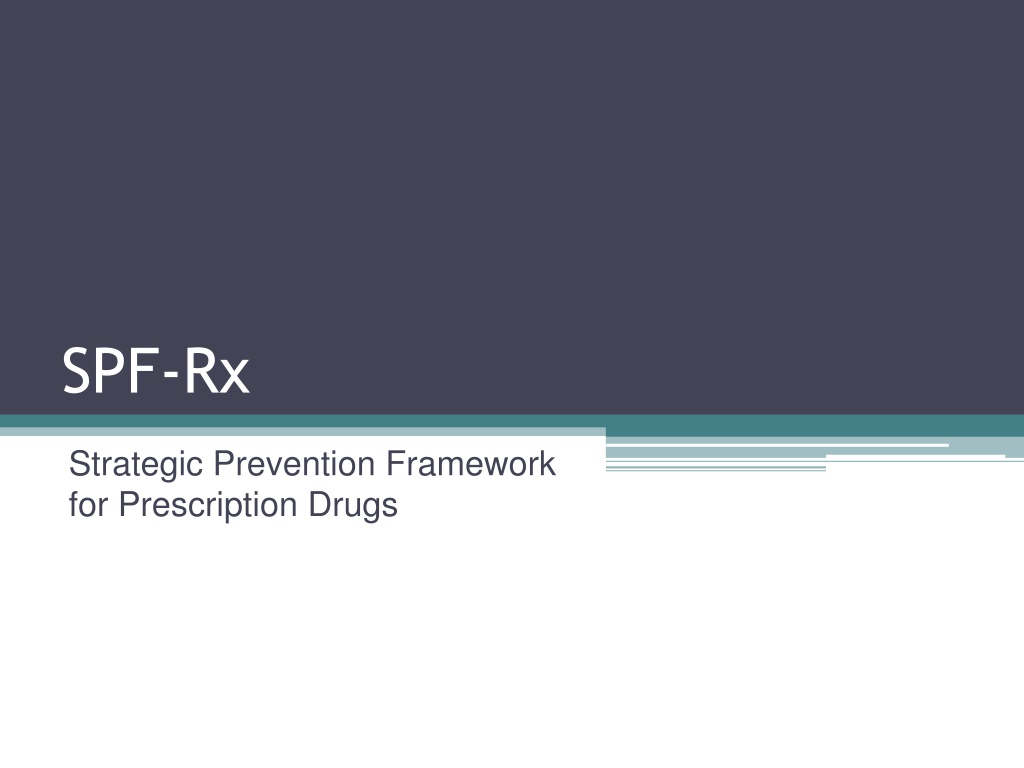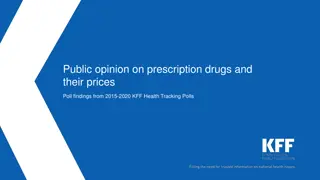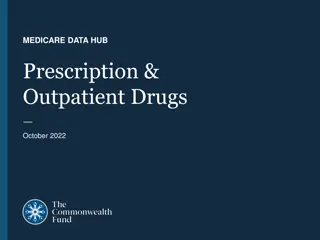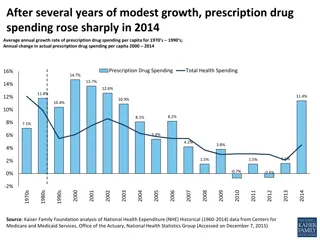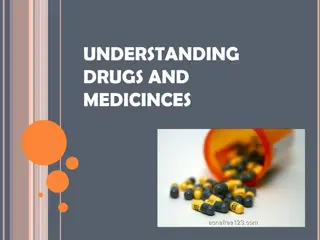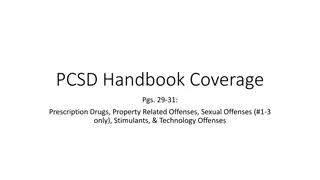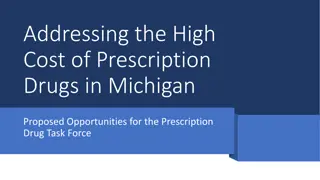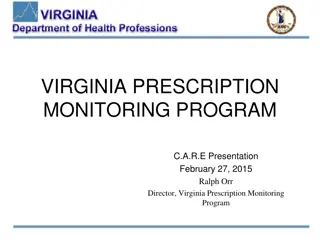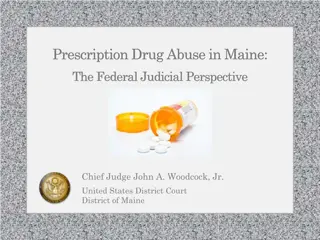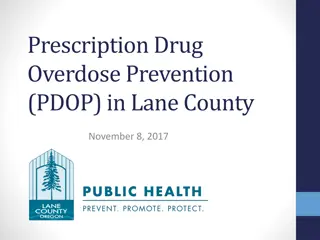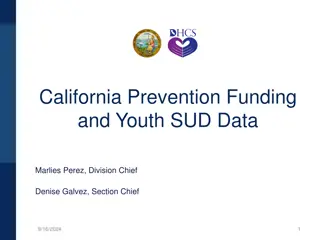Strategic Prevention Framework for Prescription Drugs (SPF-Rx)
SPF-Rx is a strategic prevention framework initiated by SAMHSA to address prescription drug abuse, focusing on raising awareness about medication dangers, overprescribing risks, and community prevention activities. The program targets youth aged 12-17 and adults 18+, aiming to combat prescription drug abuse through collaboration with pharmaceutical and medical communities. Oklahoma's state and community-level approaches involve data evaluation, training, and collaboration to strengthen prescription monitoring programs and reduce drug abuse. The NMUPD initiative emphasizes local education, guidelines promotion, evaluation, and quality of life improvements related to prescription drug overdoses.
Download Presentation

Please find below an Image/Link to download the presentation.
The content on the website is provided AS IS for your information and personal use only. It may not be sold, licensed, or shared on other websites without obtaining consent from the author. Download presentation by click this link. If you encounter any issues during the download, it is possible that the publisher has removed the file from their server.
E N D
Presentation Transcript
SPF-Rx Strategic Prevention Framework for Prescription Drugs
What is SPF-Rx? New grant from SAMHSA available only to states, U.S. territories, Pacific jurisdictions, and tribal entities that received SPF-PFS funds SAMHSA s purpose: Raise awareness about the dangers of sharing medications and work with pharmaceutical and medical communities on the risks of overprescribing Raise community awareness and bring prescription drug abuse prevention activities to a variety of sectors (e.g., communities, prescribers, parents, schools). Age groups: youth 12-17 and adults 18+ Project period: Sept. 1, 2016-August 31, 2021 Project award: $371,616 per year
Oklahomas State Level Approach Collaborate with state and local partners to develop county-level PMP data profiles for all counties Provide training and technical assistance (TA) to REOWs and CDWs regarding data (PMP and other types of data) use, interpretation, and dissemination Evaluate at state and local levels Continue to collaborate with state-level partners (e.g., OBNDD, OSDH) to strengthen prescription monitoring program (PMP) data collection sharing and processes Continue to implement state-level activities in the Governor s plan: Reducing Prescription Drug Abuse in Oklahoma
Oklahomas Community Level Approach Small amount of funds to be added to existing PFS contracts based on county size and population Activities: Collaborate with coalitions, associations, tribes, other organizations to educate the medical community on opioid prescribing guidelines and the importance of using the PMP Collaborate with above entities to promote prescribing and dispensing policies to discourage drug seeking behavior in hospital emergency depts./urgent care clinics, office-based settings, and pharmacies Provide input on, and implement at least one component of, a community-based social marketing/public education plan Participate in local evaluation activities
NMUPD Community Local education Promotion of guidelines Local evaluation Rx drug overdoses Quality of life State PMP data profile Strengthening of state level relationships Health care provider curriculum development Technical assistance to local communities State and local evaluation Federal Funding Training Technical Assistance Cross-site evaluation
What is the PMP? Prescription Monitoring Program (PMP); also called Prescription Drug Monitoring Program (PDMP) in other states Oklahoma s PMP is housed and administered by the Oklahoma Bureau of Narcotics and Dangerous Drugs (OBNDD) Database of Schedule II-V controlled substances entered into database by dispenser at the time of delivery to patient Sample of variables collected: Name of drug Dosage Number of units dispensed Prescriber Dispenser Date prescribed Date delivered Patient gender DOB Address Does not include patient race, why prescription was written, patient health information
PMP Timeline 1990: Oklahoma PMP enacted into law 2012: All dispensers of Schedule II, III, IV, and V controlled substances required to report within five minutes of delivery to customer HB 1781 enacted in November 2013: Requires OBNDD to share raw data with ODMHSAS and OSDH HB 1948 enacted in Nov. 15: Requires all health care providers to access the PMP repository, under certain conditions, to assess medical need and appropriate prescribing of opioid therapy August 2016: PMP transitioned from OBNDD in-house system to one administered by an outside vendor Current status: OBNDD has been working to obtain data from vendor, which can then be given to ODMHSAS and OSDH - process has taken much longer than anticipated
REOW Coordinator Build(s) capacity on utilizing, analyzing, and reporting real-time data in meaningful ways Develop tool(s) for collecting and organizing data Takes lead on developing county profiles describing PMP data Provide(s) recommendations on useful PMP-related indicators, training, and technical assistance on how to sustain REOWs/CDWs Respond to requests for data-related technical assistance and analysis
Sample of Brandeis University Recommended Measures Prescription rates by quarter and year, by drug class and sex Prescription rates by quarter and year, by major opioid drug category Prescription rates by quarter and year, by major stimulant drug category Mean daily dosage per patient in morphine milligram equivalents (MMEs) by quarter and year, by major opioid drug category Percentage of prescribed drugs overlapping with another prescription from the same drug class, by quarter and year Multiple provider episode rates by quarter and year, by drug schedule and age group
How many drugs are monitored by PMP? Source: Prescription Drug Monitoring Program Training & Technical Assistance Center, Brandeis University
How often is PMP data collected? Source: Prescription Drug Monitoring Program Training & Technical Assistance Center, Brandeis University
Statistics 7,660 deaths due to prescription drug overdose (1999-2015)2 Age-adjusted prescription drug overdose rate in Oklahoma (2015)2 13.4 per 100,000 Age-adjusted average prescription drug overdose rate in Oklahoma (1999-2015)2 12.6 per 100,000 Prescribers (2011)1 15,212 Dispensers(2011)1 922 Prescriptions collected (2011)1 8,733,388 Number of patient history reports (2011)1 770,545 Source(s): 1. Prescription Drug Monitoring Program Training & Technical Assistance Center, Brandeis University, 2011. 2. Centers for Disease Control and Prevention, National Center for Health Statistics. Multiple Cause of Death 1999- 2015 on CDC Wonder Online Database, released 2016.
Potential possibilities utilizing PMP data Ascertaining overdose death rate by prescriptions from prescribers Trends in doctor shopping by type of prescription drug (schedules II-V) Mean daily dosage in MMEs by month, and/or year
